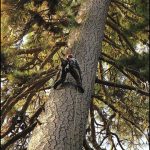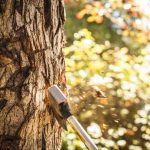Leaf-Eating Insects and How to Get Rid of Them
Leaf-eating insects, also referred to as foliage-feeders or defoliators, can be terribly destructive. In fact, some of the larger pests can do away with an entire plant in just one evening. They devour tree and plant leaves until only the fragile skeletons remain. Bugs like caterpillars, moths, butterflies and grasshoppers are the main culprits, but slugs and snails can also be to blame, especially in damp environments like the great Northwest. Below we’ve listed a few of the leaf-eaters we deal with most often, and what you can do to get rid of them.
Leaf rollers
The caterpillars, or larvae, of more than 200 moth species are categorized as leaf rollers. They roll up, fold, and web together the leaves of many tree species (mostly hardwoods), feeding and living inside until they consume the leaf entirely. The first generation of eggs are laid on the tree’s branches and the following generations are laid on the leaves that emerge in the Spring. They especially love trees that sprout new foliage throughout the Summer. If you decide to use an insecticide to manage them, you must be thorough as the rolled-up leaves offer them protection. You can also simply pinch the leaves to kill the little buggers inside.
Elm Leaf Beetle
These defoliators attack American, English, Siberian and other Elm species. From egg to pupa they are noticeable by their bright yellow color. The larvae skeletonize the leaves from the underside, while adult feeding causes “shot holes” in the leaf tissue. Eggs hatch around May or June and larvae feed for a while before migrating to the ground where they pupate and lay more eggs. The second and final generation of the year will hatch a couple of weeks later. Heavy infestations of Elm Leaf Beetles can result in premature leaf loss and dieback. They won’t kill a tree on their own, but they can weaken the tree and make it more susceptible to Elm Bark Beetles, which often carry Dutch Elm Disease. It is best to address these insects when larvae are small and before damage is severe.
Webworm
Webworms are a common, native pest in Oregon, most frequently affecting Alder, Ash, Cottonwood, Madrone and many others. They are white with small spots or hairs and can reach one inch in length before they pupate and become white tiger moths. The telltale sign of a Webworm infestation is heavy webbing at the ends of branches in the Fall in addition to leaf loss. Rest assured they are doing more harm to the look of your yard than they are to the tree. The web masses can reach one foot in diameter, making them pretty unsightly. The most effective way to get rid of Webworms and tiger moths is to simply cut out the infested branches and burn them, but its important that you not cut out any large ones. You can also try to open up the webbing with a stick so that nearby birds can snack on the bugs inside.
Management Considerations
While tree death is uncommon, leaf-eating bugs can cause reduced growth and aesthetic problems. To prevent insect infestations to begin with, do your best to keep your trees healthy year round. This will help them resist disease and tolerate foliage loss.
Nature will often take care of these pests for you in the form of birds and parasites. But, sometimes nature needs a little assistance. If you decide to use an insecticide, do so as a last resort as they can sometimes make problems worse– such as killing beneficial bugs or harming predators.
Need help with trimming or tree removal? Call Inexpensive Tree Care today at (503) 504-4179 or visit our contact page.



